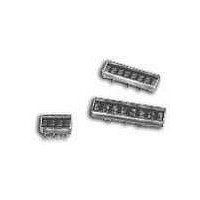HCMS-3903 Avago Technologies US Inc., HCMS-3903 Datasheet - Page 17

HCMS-3903
Manufacturer Part Number
HCMS-3903
Description
LED DISPLAY 5X7 4CHAR 3.8MM GRN
Manufacturer
Avago Technologies US Inc.
Series
HCMS-39xxr
Datasheet
1.HCMS-3902.pdf
(18 pages)
Specifications of HCMS-3903
Display Type
Alphanumeric
Millicandela Rating
*
Internal Connection
*
Size / Dimension
*
Color
Green
Configuration
*
Voltage - Forward (vf) Typ
*
Package / Case
12-DIP
Number Of Digits/alpha
4
Digit/alpha Size
0.15" (3.8mm)
Number Of Digits
4
Character Size
2.11 mm x 3.71 mm
Illumination Color
Green
Wavelength
574 nm
Operating Voltage
3.3 V
Operating Current
5 mA
Maximum Operating Temperature
+ 85 C
Minimum Operating Temperature
- 40 C
Luminous Intensity
252 ucd
Power Consumption
0.766 W
Viewing Area (w X H)
15.46 mm x 3.71 mm
Common Pin
None
Lead Free Status / RoHS Status
Lead free / RoHS Compliant
Lead Free Status / RoHS Status
Lead free / RoHS Compliant, Lead free / RoHS Compliant
Available stocks
Company
Part Number
Manufacturer
Quantity
Price
Company:
Part Number:
HCMS-3903
Manufacturer:
Avago Technologies
Quantity:
135
Appendix B. Electrical Considerations
Current Calculations
The peak and average display current requirements
have a significant impact on power supply selection. The
maximum peak current is calculated with Equation 3 in
Table 3.
The average current required by the display can be
calculated with Equation 4 in Table 3.
The power supply has to be able to supply I
transients and supply I
range on V
signifi cantly changing the display brightness.
V
The display uses two independent electrical systems.
One system is used to power the display’s logic and the
other to power the display’s LEDs. These two systems
keep the logic supply clean.
Separate electrical systems allow the voltage applied to
V
can vary from 0 to 5.5 V without affecting either the Dot
or the Control Registers. V
to 5.5 V without much noticeable variation in light output
to the human eyes. There is also no pixel mismatch
observed.
The intensity of the light output takes a plunge if
operated less than 3.1 V. There is also no pixel mismatch
observed at voltage as low as 2.6 V. However, operating
below 3.1 V is not recommended. Dimming the display by
pulse width modulating V
V
the displayed message or the display intensity. However,
operating below 3 V may change the timing and logic
levels and may cause Dot and Control Registers to be
altered. Thus, operation of the display below 3.0 V is not
recommended.
The logic ground is internally connected to the LED
ground by a substrate diode. This diode becomes
forward biased and conducts when the logic ground
is 0.4 V greater than the LED ground. The LED ground
and the logic ground should be connected to a common
ground, which can withstand the current introduced
by the switching LED drivers. When separate ground
connections are used, the LED ground can vary from
-0.3 V to +0.3 V with respect to the logic ground. Voltages
below -0.3 V can cause all the dots to be ON. Voltage
above +0.3 V can cause dimming and dot mismatch.
Using a decoupling capacitor between the power supply
and ground will help prevent any supply noise in the
frequency range greater than that of the functioning
display from interfering with the display’s internal
circuitry. The value of the capacitor depends on the series
17
LOGIC
LED
LOGIC
and V
and V
can vary from 3.0 to 5.5 V without affecting either
LOGIC
LED
LED
Considerations
allows noise on this supply without
to be varied in dependently. Thus, V
LED
LED
LED
is also not recommended.
can be varied between 3.1
(AVG) continuously. The
PEAK
LED
Table 3. Equations.
resistance from the ground back to the power supply
and the range of frequencies that need to be suppressed.
It is also advantageous to use the largest ground plane
possible.
Electrostatic Discharge
The inputs to the ICs are protected against static
discharge and input current latch up. However, for best
results, standard CMOS handling precautions should
be used. Before use, the HCMS-39XX should be stored
in antistatic tubes or in conductive material. During
assembly, a grounded conductive work area should be
used and assembly personnel should wear conductive
wrist straps. Lab coats made of synthetic material
should be avoided since they are prone to static
buildup. Input current latch up is caused when the
CMOS inputs are subjected to either a voltage below
ground (V
V
into the input. To prevent input current latch up and ESD
damage, unused inputs should be connected to either
ground or V
inputs until V
Equation 1:
T
Where:
T
T
Rθ
P
Equation 2:
P
Where:
P
N = number of pixels on (maximum 4 char * 5 * 7 = 140)
I
Duty Factor = 1/8 * Osccyc/64
Osc cyc = number of ON oscillator cycles per row
I
V
Equation 3:
I
Where:
I
M = number of ICs in the system
20 = maximum number of LEDs on per IC
I
Equation 4:
I
(See Variable Definitions above)
PIXEL
LOGIC
PEAK
PEAK
PIXEL
LED
A
J
J
LOGIC
D
D
D
LOGIC
= ambient temperature surrounding the display
MAX = T
MAX = maximum IC junction temperature
= total power dissipation
= total power dissipation
JA
= (N * I
(AVG) = N * I
= thermal resistance from the IC junction to ambient
= maximum instantaneous peak current for the display
= peak pixel current.
= peak current for one LED
= M * 20 * I
= IC logic current
= logic supply voltage
(V
IN
PIXEL
A
IN
> V
LOGIC
+ P
< ground) or to a voltage higher than
LOGIC
LOGIC
* Duty Factor * V
D
PIXEL
PIXEL
. Voltages should not be applied to the
* Rθ
has been applied to the display.
) and when a high current is forced
JA
* 1/8 * (oscillator cycles)/64
LED
) + I
LOGIC
* V
LOGIC














